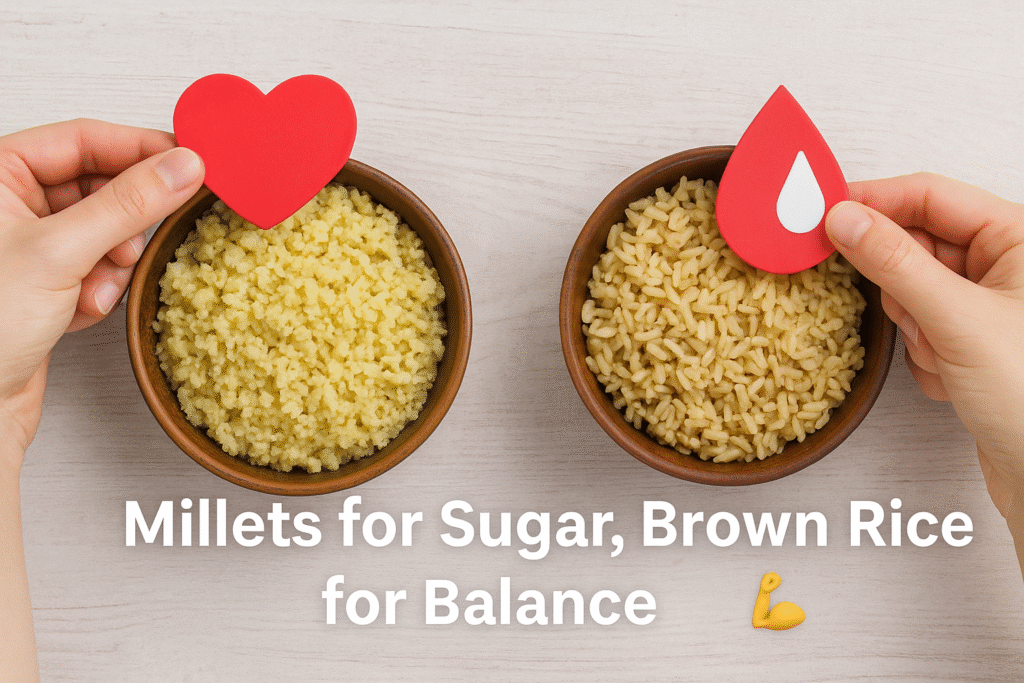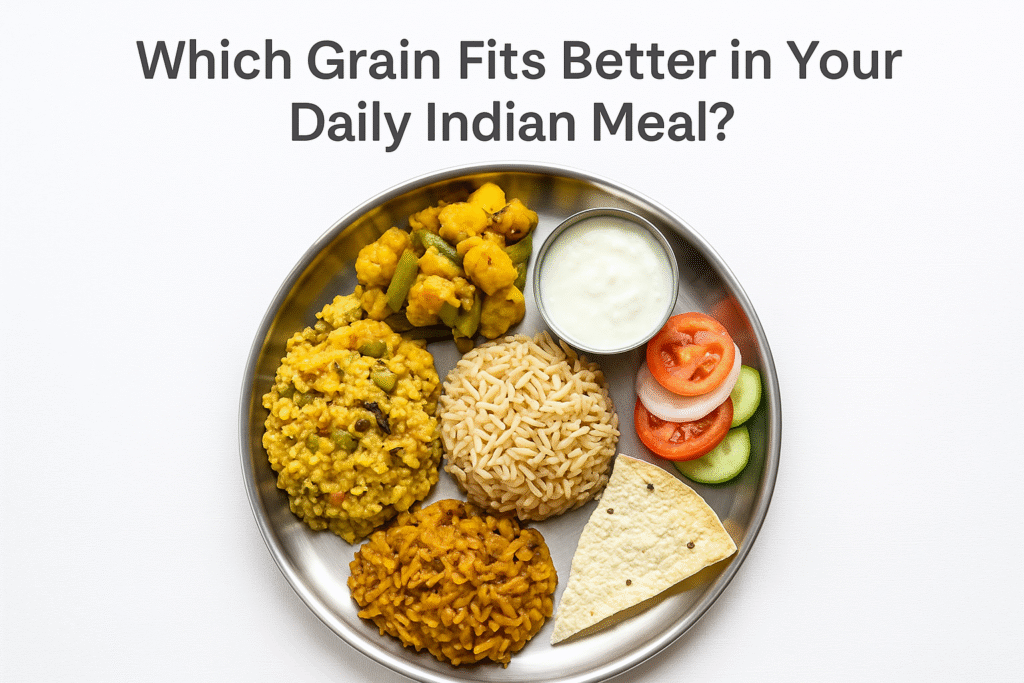Across India, people are rethinking what goes on their plate. Many are dropping polished white rice for better grains like millets and brown rice. It’s not just about calories anymore, it’s about nutrients, digestion, and long-term health. The question that keeps popping up is pretty simple — what’s actually better: millets or brown rice?
This topic matters more in India because grains are our daily energy base. Whether it’s idli, dosa, rotis, khichdi, or pulao — grains drive most of our meals. Millets are ancient Indian crops that grow in tough soils and give strong nutrition. Brown rice, on the other hand, is rice in its whole form with bran and germ intact, making it a better pick than white rice.
People often get confused — both look earthy, both sound healthy. But they’re not the same. Their fibre, minerals, digestion, and even cooking needs vary. This blog sorts out all that mess and helps you figure which one suits your health goals and lifestyle. No fancy talk, just clear info you can use every day.
Understanding Indian Millets and Their Main Nutritional Strengths
Millets aren’t a new fad; they’re ancient crops from our own fields. You’ll find ragi (finger millet) in the South, bajra (pearl millet) in the North, foxtail millet in the East, and barnyard millet spreading across small towns. They’ve been on our thalis for centuries before rice took over.
Each type packs something diff. For example:
• Ragi has loads of calcium and iron
• Foxtail millet gives steady energy with slow carbs
• Bajra brings high protein and magnesium
• Kodo millet helps in easy digestion
Per 100 g cooked, millets roughly carry 6 g of protein, 3–4 g of fibre, and a good mix of iron, magnesium, B-vitamins, and antioxidants. They digest slower than white rice, which keeps sugar spikes in check — that’s why millets often come up in discussions on diabetes-friendly diets in India.
They’re also gluten-free, making them handy for those with wheat sensitivity. A small win for anyone watching gut health.
What Is Brown Rice and How It Differs From White Rice Nutritionally
Brown rice is basically rice with just the outer husk removed. The bran and germ layers stay, giving it more fibre, minerals, and healthy oils. Unlike polished white rice, it keeps its natural nutrients intact.
Nutrition per 100 g cooked:
| Nutrient | Brown Rice | White Rice | Millets (avg) |
|---|---|---|---|
| Calories | ~111 | ~130 | ~120 |
| Protein | 4.5 g | 2.4 g | 6.1 g |
| Fibre | 1.8 g | 0.4 g | 3.5 g |
| Glycaemic Index | 68 | 73–89 | 50–55 |
| Minerals (Iron, Mg) | Moderate | Low | High |
That little chart shows it well — brown rice wins against white rice, but millets still edge it out on certain nutrients.
Brown rice has a mild nutty taste and chewy texture. It’s great for those shifting gradually from white rice to a whole-grain lifestyle. Just needs extra soaking and more cooking time. Many households in metro cities now use it for daily meals or combine it half-half with regular rice.
Nutrient Comparison Between Millets and Brown Rice for Indian Diet
Let’s put them side by side. Both millets and brown rice are whole grains but vary sharply in fibre and mineral content.
| Key Nutrients | Millets | Brown Rice |
|---|---|---|
| Protein | 6–7 g | 4–5 g |
| Fibre | 3–4 g | 1.8 g |
| Iron | 3–4 mg | 1 mg |
| Magnesium | 100–150 mg | 40–50 mg |
| Calcium | 100–350 mg (ragi tops) | 10 mg |
| Glycaemic Index | Low (50–55) | Medium (68) |
| Gluten | Absent | Absent |
So, millets deliver more fibre and micronutrients, while brown rice provides moderate nutrients but easier cooking and milder taste.
If you’re targeting blood sugar stability, millets have an edge because of slow digestion. For those who want smoother texture and fewer cooking steps, brown rice might fit better.
Health Benefits and Possible Concerns When Eating Millets or Brown Rice

Both grains hold strong nutrition, but each has its small caveats too.
Millets — the fibre king with a few quirks
• Lower glycaemic index helps control blood sugar and diabetes risk.
• Keeps you full longer — nice trick if you’re eyeing weight control.
• Boosts gut movement due to high fibre.
• Some millets have natural anti-nutrients (like phytic acid), which may reduce mineral absorption — soaking or light roasting helps fix this.
Brown rice — wholesome but not perfect
• Contains more fibre than white rice but still less than millets.
• Keeps cholesterol levels in check.
• Its bran layer may store small amounts of arsenic from soil, so washing and soaking properly is smart.
• Cooking time longer, taste slightly chewy — few people don’t enjoy that.
Verdict: For diabetics, millets win hands-down. For general health maintenance and easy daily use, brown rice stays convenient.
Which Works Better in Indian Meals and Lifestyle Based on Availability and Habit

Millets match better with Indian home-cooked foods. Think ragi dosa, bajra rotla, kodo khichdi, foxtail pulao — all traditional and time-tested. Farmers grow them locally, so they’re pocket-friendly and sustainable too.
Brown rice, though, fits easily into urban kitchens. You can use it for biryani, pongal, or even sushi rice. Supermarkets keep it handy, though still costlier per kilo than local millets.
India’s government even named 2023 as International Year of Millets. That’s because millets grow well in dry soil, need less water, and survive heat better than paddy. In a water-stressed country like ours, that’s a major advantage. So from an eco and health view, millets make more sense for Indian diets long term.
Practical Ways to Include Millets and Brown Rice in Daily Indian Meals
Changing eating habits works better slowly. You can start by swapping once or twice a week.
Easy millet ideas:
• Ragi porridge for breakfast
• Foxtail millet khichdi for lunch
• Bajra roti with dal and sabzi at night
Simple brown rice swaps:
• Brown rice pulao instead of white rice
• Brown rice curd bowl for light dinner
• Add mix of brown and white rice during transition phase
Cooking tips:
• Soak brown rice for 45 min before cooking; use 2.5× water.
• Millets cook faster if soaked for 30 min; ratio 1 : 2 water works well.
Each gives a different mouthfeel — experiment until you find your comfort bowl.
Which Grain Should You Choose and When Based on Health Goals
If your goal is better sugar control, go with millets like foxtail or little millet.
If you’re after easy cooking and balanced nutrients, brown rice fits fine.
For weight loss, millets again score higher for fibre and satiety.
A balanced approach might be smartest — mix both across the week. That way your body gets variety and doesn’t get bored with one texture. Real health isn’t about one “super grain”, it’s about steady choices
Putting It All Together for the Indian Plate
Both millets and brown rice carry real value for Indian eaters. Millets show higher fibre, more protein, and lower glycaemic index — they’re great for diabetes, digestion, and long-term health. Brown rice, meanwhile, offers better taste acceptance, easier cooking, and a gentle shift away from polished rice habits.
If you live in cities and want a simple whole-grain swap, start with brown rice. If you’re open to experimenting, millets bring more nutrients per bite. Local markets, online stores, and even government campaigns make them easy to get now.
Don’t overthink it — no grain alone fixes your health. What matters is rotation, portion control, and balance with pulses, veggies, and healthy fats. Your thali should feel colourful and natural, not complicated. So, whether it’s millet upma or brown rice pulao tonight, just eat with intent, not guilt. That’s the real win.


Leave a Reply